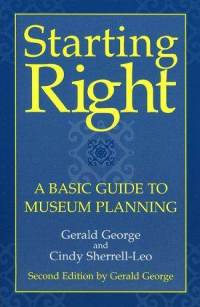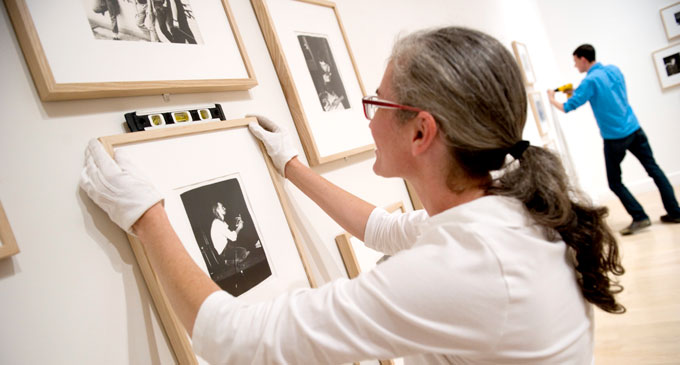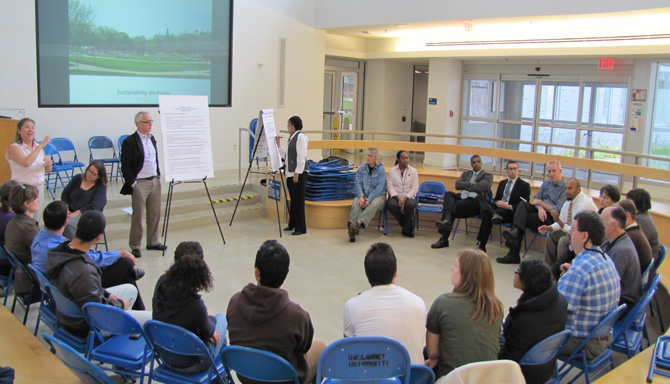Starting Right

by Gerald George and Cindy Sherrell-Leo.
Economic and cultural issues that no one contemplated facing 50 years ago are critical to the planning process for today's successful museum. This new edition of Starting Right, revised from the first edition by Gerald George and Cindy Sherrell-Leo, still provides sound guidance in a handbook designed to explain the basics of museum planning in an evening's reading but it has been fully revised and updated to address the current issues facing new museums. Here in straightforward language you will find out what a museum is-philosophically and historically-some pros and cons of establishing your museum, up-to-date resource lists, and good basic advice on all aspects of museums from the choice of a building through collections care, registration, exhibitions, conservation, staffing, financial management, and fund raising.
|
Anthropology Education in Museums
Need your input!
Museums are among the most important contributors to informal education for children and adults. This is particularly true for the discipline of Anthropology. The American Anthropological Association has created a task force on Anthropology education to identify strengths and challenges for teaching and learning in K-12 schools, community colleges, colleges of education, and museums. As a member of the task force, museumclasses.org instructor Karl Hoerig has developed an online survey to learn more about the state of Anthropology education in museums. Please take a few minutes to respond to the survey at the following link, even if your museum does not include anthropology as a primary subject.
http://research.zarca.com/k/SsRXQTsQRUsPsPsP
Karl Hoerig is director of Nohwike' B=E1gowa (House of Our Footprints), the White Mountain Apache Cultural Center and Museum, in Fort Apache, Arizona. The position requires multifaceted involvement in the community, a mix of museum tasks, heritage promotion, cultural heritage resource protection and management, capacity building, economic development and enhancing sovereignty. Karl Hoerig has a PhD in anthropology from the University of Arizona.
|
NSCC Supports Education
The fifth grade field trip is expensive - $400. The poorest kids - those most likely to need the trip - can't afford to go. So, while their classmates excitedly talked about four days in New York City, these children planned to stay in the classroom with a substitute teacher.
Education is our mission. We believe strongly in museums and travel and networking as learning opportunities. When we learned that there were children unable to go on this exceptional trip, which includes the Metropolitan Museum of Art, Northern States Conservation Center decided to help. We donated $1,000 with instructions to the teacher to spread it out as far as she could. Hopefully some parents can provide some money, rather than needing the full amount paid. These children all have good grades and good behavior and deserve the treat of visiting the Big Apple for the first time.
If you would like to help the children of Piedmont Elementary School in Charleston, West Virginia, please add your contribution to ours by sending money c/o Mrs. Landers, Fifth Grade Teacher, Piedmont Elementary School, 203 Bradford Street, Charleston, WV 25301.
|
Regional Workshops
- July 11-12, 2013, Bryn Mawr College, Bryn Mawr, PA, $270 AASLH members/$345 nonmembers. $40 discount if fee received by June 5.
|
|
|
Welcome to the Collections Caretaker e-Newsletter from Northern States Conservation Center. The newsletter is designed to bring you timely and helpful content that is pertinent to situations we all encounter in our museum and archives work. Feel free to let us know what topics you would like to see featured in Collections Caretaker or even contribute an article.
|
|
Staffing a New Museum
A museum or cultural center needs staff in order to carry out its mission. The types and number of staff members vary according to the size, resources, and ambitions of the museum. Some small museums get by solely with volunteers and perhaps only one or two staff. Other large institutions, like the National Museum of the American Indian at the Smithsonian Institution, employ hundreds of staff members. Your museum may use paid employees or you may choose to use volunteers, but what both of these support roles require is clear position descriptions, responsibilities, and regular performance appraisals.
 | | Staff at the Weatherspoon Art Museum prepare a new display. |
The first employee of most museums is the Executive Director. At a tribal museum or cultural center, the Executive Director might report to tribal authorities or a committee. If the museum or cultural center is a separate entity, the Executive Director would report to a board of directors, who are responsible for hiring, directing, and evaluating the performance of the Director. This is the single most important hire that the tribal authorities or board will make, as the Executive Director will do all subsequent hiring and chart the direction for the institution. The text, Starting Right, has a very detailed description of the process through which you will hire your first Executive Director. It is critical that the person is well-qualified for the position-and while political savvy will be a necessary skill for the Director to have, politics should have no bearing on the actual selection and hiring of your Director.
The second position of great importance and which you might consider hiring after the Executive Director is a Facilities Manager. It may seem premature, but having someone whose responsibility it is to oversee your facility is incredibly important. This person will either carry out, or supervise staff (paid or unpaid) to keep up with regular cleaning (restrooms, floor, windows), grounds keeping (mowing, sweeping sidewalks, snow shoveling, tree trimming, and gardening plus maintaining any outdoor program space you may have designated),and periodic maintenance (deep cleaning, battery changes, bulb changes, etc.). Your facility will give all visitors that important good first impression, and is critical to success.
Following a facility manager, it is important to have some administrative assistance. If the Executive Director is carrying out the duties of curator, program manager, development officer, and public relations person in addition to those of the Director, that person will need someone to help manage volunteers, do routine tasks like correspondence and making bank deposits, and stand in line at the post office. If you are paying your Executive Director well, you will not want their valuable time to be taken up with necessary, but time-consuming, routine tasks.
If you can hire a development director or grant writer, you would be wise to do so. No matter what the funding of your institution, grants can be a critical part of your funding mix. Grant writing requires a very specific skill set: great writing skills, plus the ability to align your existing or dream programs with the funding interests of foundations, corporations, or government entities. A development director would work more broadly on securing funding for your institution. In smaller museums, much of the fundraising responsibility rests with the Executive Director. If your size or ambitions permit, one of these two staff members might allow you to grow faster or maintain your momentum.
If your new museum/cultural center has an ambitious agenda, and will have a collection, you will want to consider hiring support staff to serve as Curator, and Program Manager (or Educator). These positions will be responsible for the chief programmatic responsibilities of your institution.
The Curator, or related position (even if titled differently) will have chief responsibility for the collection. In tribal communities this is a critical role. Museum collections are expected to be held in perpetuity-and in non-tribal museums, this generally means that artifacts will rarely, if ever, be used for their original purpose because use is considered damaging. However, in tribal museums, it is likely that many artifacts will remain in ritual use. For a tribal museum, an ideal curator would be well-versed, if not expert, at the material culture of the tribe, culturally aware, trained in museum work, and adept at balancing competing, but equal, concerns.
Ideally, the position of Program Manager or Educator would have the primary responsibility for all of the public programming that goes on at the museum. Depending on your goals for the museum/cultural center, you may be conducting programs for your community as well as for the general public. School tours are an excellent way to teach young people about your history and culture in an environment where the message is created and controlled. For the youth in the community, it might be an opportunity to see things that they had only heard about before. This same staff member could also supervise the volunteers who work in the galleries and those who give tours.
Beyond these positions, you might wish to consider employing people who would open the museum and staff it beyond the normal work week, particularly weekends and holidays. It is helpful for volunteers who work in the museum during off hours to have a paid staff member present to take charge when something happens, and to be responsible for opening and closing the museum.
A "Docent" is a specific type of volunteer. The word has come to mean museum teacher. Docents ordinarily lead tours through gallery spaces, but can also be stationed in galleries to work with touring visitors. Like other positions, this is fairly specialized, requiring gregarious types who are willing to engage visitors, and have the patience to also work with children. Aside from the paid staff, these are generally the volunteers that need the most training and supplemental material to read, because they get more specific questions about the museum and its collections than just about anyone else. It is not necessary to call tour guides or gallery attendants "docents"-usually this term is always used in art museums, but history and cultural museums may or may not use the term.
The paradigm for staffing small museums for the last 50 years in the United States has been to use a minimal number of paid staff, and supplement that staff with unpaid volunteers. This paradigm has shifted (and some time ago), but most museums have not yet caught up. If you think that you can recruit, train, and retain volunteers to staff your galleries, or to serve as a receptionist, do it. It would be advisable to figure out how to involve community members, leaders and elders, especially in programming. An Elders Board might be a wonderful way to involve those who know the most. It is up to you whether you use unpaid staff, but they can certainly help stretch scarce resources to allow you to provide more programs
Excerpt from the course MS256 Establishing a Museum.
Claudia Nicholson is Executive Director of the North Star Museum of Boy Scouting and Girl Scouting in North St. Paul, MN. Claudia began her career in museums at the National Archives in Washington, DC. After earning her Masters Degree in History Museum Studies from the Cooperstown Graduate Program, she became Curator of Collections for the South Dakota State Historical Society in Pierre. While there, she worked with a Native American advisory committee to create a groundbreaking exhibit on Sioux life in South Dakota. After seven years, she moved to St. Paul to become a curator at the Minnesota Historical Society. She has over 30 years experience in museums and historical organizations.
|
Components of a Strategic Plan
By Sue Near
What are the components of a strategic plan?
Mission: The purpose of the museum, why you exist, and the public impact of your existence.
Core values: These are the beliefs that drive your organization. They focus on what is most important in the way that your organization is operated on a daily basis.
Vision: The articulation of what your organization wants to become in the future.
Goals: What does the organization want to accomplish? Goals are broad statements related to specific key areas identified by board and staff.
Context: For each goal, a framework is provided for why the goal has been included in the plan.
Objectives: Objectives states how the goals will be accomplished.
They are measurable and have a timeline. For each objective, identify who will oversee completion of the objective; when the objective is expected to be completed; and what will be needed to accomplish the objective.
 | | Long-range planning session at Gallaudet University. |
Strategies are broad, overall priorities or directions adopted by an organization. Strategies are choices about how best to accomplish an organization's mission. To illustrate the point here are some sample strategies:
Strategy Example 1- In pursuit of their mission to "increase opportunities to experience world class art in our community," a relatively new museum chose an innovative acquisition strategy -- they chose to borrow much of their collection, rather than primarily raise money to increase their art collection.
Sample long-term objectives within this strategy:
- At least 50% of our exhibitions will be from other museums' collections
- Focus our art collecting on 20th century California artists
Sample short-term objectives within this strategy:
- Within the next year, collaborate with other museums to put on one exhibition that highlights 19th century Japanese drawings and one exhibition that highlights French impressionists.
Strategy Example 2- After many years spent caring for neglected animals, an SPCA (Society for the Prevention of Cruelty to Animals) shifted its overall program strategy toward prevention. To implement the strategy, all programs developed and implemented an education component to their service, and the staff increased their efforts to
pass legislation designed to prevent unwanted pets and animal abuse.
Sample long-term objectives within this strategy:
- Within the next 5 years, reduce by at least 50% the number of animals we have to put to sleep.
- Get new legislation passed that increases regulation of "puppy mills."
Sample short-term objectives within this strategy:
- Within the next year, each department will develop and implement a plan for adding an education component to their scope of work.
- Hire an education director to coordinate our education efforts.
- Develop and implement a "Spay and Neuter Campaign."
In each case, the organization has made a clear choice among competing options about how best to pursue its mission. It is easy to see how each of these core strategies might be translated into specific goals and objectives over a period of several years and for the immediate future. What is not easy to see is how much effort, experimentation, and discussion were required to find these successful strategies. The strategic planning process helps organizations identify various strategic options to make intelligent choices in developing strategic directions and plans.
(Excerpt from the course MS 109: Museum Management.)
Sue Near is special projects manager at the Montana Historical Society in Helena. She served over 20 years as director of museum services. Her extensive administrative experience includes grant-writing, heritage tourism, educational outreach, public relations, marketing, planning for new museum construction, and project and event management. She is an accreditation visiting committee member for the American Alliance of Museums, has conducted peer reviews for the Museums Assessment Program, and has reviewed and served on grants panels for the Institute for Museum and Library Services and the National Endowment for the Humanities. Ms. Near is a graduate of the Museum Studies Program at the University of Delaware and the Getty's Museum Management Institute.
|
Northern States Conservation Center (NSCC) provides training, collection care, preservation and conservation treatment services. NSCC offers online museum studies classes at www.museumclasses.org in Collections Management & Care, Museum Administration & Management, Exhibit Practices and Museum Facilities Management.
Sincerely,
Helen Alten, DirectorBrad Bredehoft, Sales and Technology Manager Peggy Schaller, Publications Manager
|
|
|
|
|
|
|



